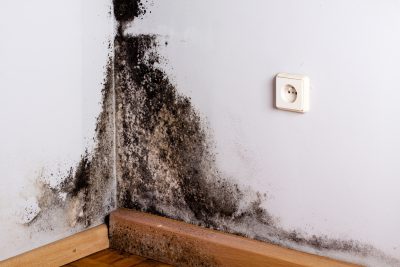Condensation, damp & mould
No one wants to live in a damp home.
Damp can cause mould on walls and furniture and cause wooden window frames to rot. It’s also unhealthy.
Some dampness is caused by condensation. This can lead to a growth in a mould that appears as a cloud of little black dots. For other kinds of damp, see below.
This is common when you have an open utility room and a condenser tumble dryer for example.
Condensation occurs when moist air comes into contact with a colder surface like a wall, window, mirror etc. The air can’t hold the moisture and tiny drops of water appear. It also occurs in places the air is still, like the corners of rooms, behind furniture or inside wardrobes.

Condensation mould is unsightly and can cause health problems
How to reduce condensation at home
1) Produce less moisture
Simple things make a huge difference, like keeping the lids on pans when cooking, drying clothes outdoors (and especially not on radiators), venting your tumble dryer to the outside and avoiding using paraffin heaters or flue-less bottled gas heaters which produce a lot of moisture.
2) Let the moist air out and the fresh air in
Extractor fans are an effective way to get rid of moist air and steam so that fewer condensation forms. Some very modern homes have extractor fans that run continuously, fitted in the ceilings of bath and shower rooms. They use very little electricity. If your home doesn’t already have extractor fans then it’s well worth getting them fitted in the bathroom and kitchen. Fans that run on a timer, humidistat or pull-cord typically have a rating of 8-30W. A 30W appliance would need to run continuously for nearly a day and a half to use one unit (about 15p) of electricity.
Stop moist air getting into the rest of your home. When cooking or bathing, keep the kitchen or bathroom door shut and open the window so that the steam goes outside instead.
Meanwhile, let fresh air circulate to avoid mould forming where the air is still. Make sure there is a gap between your furniture and the walls, and give wardrobes and cupboards a good airing sometimes.
3) Insulate and draught-proof your home
Warm homes suffer less from condensation, so you should make sure your house is well insulated. This means insulating your loft to the recommended depth of 270mm (about 11 inches), and your cavity walls (if your house has them). Your windows and external doors should be draught-proofed, and you should consider secondary glazing if your windows are draughty. Thermal board plastering is also effective you are renovating your home.
4) Heat your home a little more
While you don’t want to waste money heating rooms you don’t use, very cold rooms are more likely to get damp and mould. Set the thermostatic radiator valve to 1 in unused rooms so the radiator gives out a little bit of heat whenever you have the heating on. If you don’t have central heating, consider using a room heater with a timer and temperature control. Remember, unused rooms will need good airing from time to time.
Other helpful equipment
You can catch condensation dripping from windows with condensation channels and sponge strips (available from DIY shops). If you wipe down windows and sills in the morning this will also help, but be sure to wring out the cloth rather than dry it on a radiator. In extreme circumstances, you may need to invest in a dehumidifier. These can help a lot but cost anything from £40 to over £200 and larger ones can be quite costly to run.
How to get rid of mould
If you already have mould on your walls and ceilings then you need to clean it off properly. An effective two-stage method is to start by cleaning off the mould with a spray containing bleach. This will help remove the staining that persistent mould can leave behind. Leave to dry overnight and then spray the affected area with an anti-fungal wash and allow that to dry. Always follow the manufacturer’s instructions and consider wearing a face mask when spraying.
You could also treat the affected area with mould-resistant paint, available from most major hardware stores.
Condensation is not the only cause of damp
‘Penetrating damp’ is caused by moisture coming into the house through leaking or cracked pipework, a damaged roof, blocked guttering, gaps around window frames and cracked or defective rendering and brickwork. All these problems can be remedied.
‘Rising damp’ is due to a defective (or non-existent) damp course. This will leave a ‘tide mark’ about a metre above the floor. Fixing rising damp is a job for a qualified builder.
NB: Newly built homes can sometimes feel damp because the water used during their construction is still drying out.






